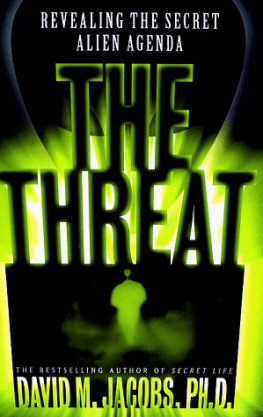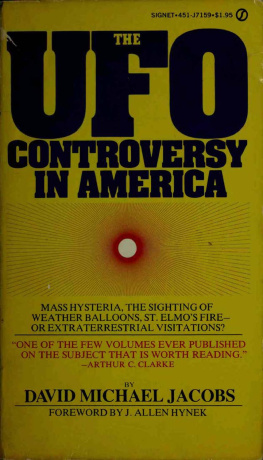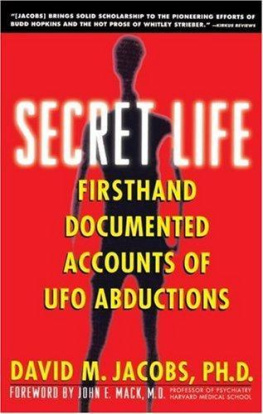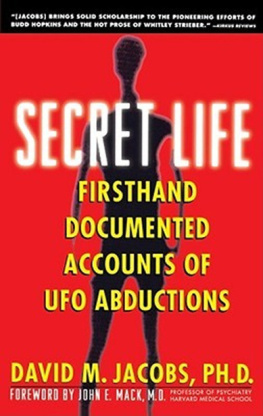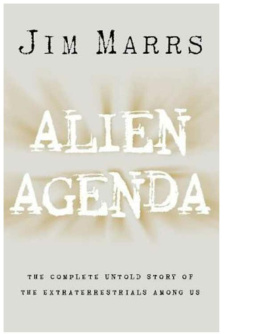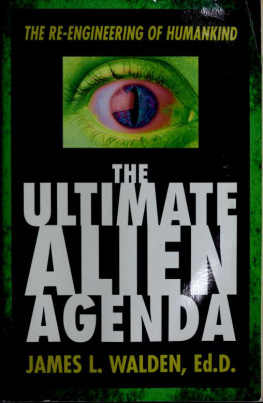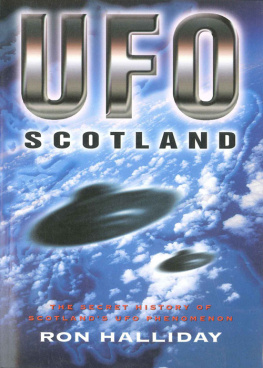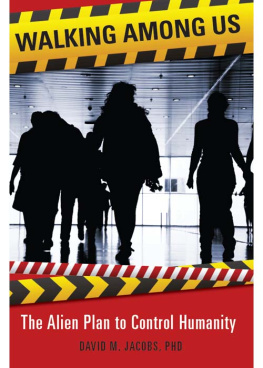
The Threat: Revealing the Secret Alien Agenda
Pages
The Threat: Revealing the Secret Alien Agenda
David Jacobs
This book was produced in EPUB format by the Internet Archive.
The book pages were scanned and converted to EPUB format automatically. This process relies on optical character recognition, and is somewhat susceptible to errors. The book may not offer the correct reading sequence, and there may be weird characters, non-words, and incorrect guesses at structure. Some page numbers and headers or footers may remain from the scanned page. The process which identifies images might have found stray marks on the page which are not actually images from the book. The hidden page numbering which may be available to your ereader corresponds to the numbered pages in the print edition, but is not an exact match; page numbers will increment at the same rate as the corresponding print edition, but we may have started numbering before the print book's visible page numbers. The Internet Archive is working to improve the scanning process and resulting books, but in the meantime, we hope that this book will be useful to you.
The Internet Archive was founded in 1996 to build an Internet library and to promote universal access to all knowledge. The Archive's purposes include offering permanent access for researchers, historians, scholars, people with disabilities, and the general public to historical collections that exist in digital format. The Internet Archive includes texts, audio, moving images, and software as well as archived web pages, and provides specialized services for information access for the blind and other persons with disabilities.
Created with abbyy2epub (v.1.7.2)
1. Recognizing the Signal
In the 1996 blockbuster motion picture Independence Day, hostile aliens come to Earth hell-bent on death and destruction. Resourceful humans band together, defeat the common enemy, and save Earth. This Hollywood scenario is not newit has dominated screen versions of alien contact since 1951 with the release of The Thing, in which a single alien wreaks havoc on a group of humans.
A more peaceful version of alien contact has also become a cultural staple. From 1951 and The Day the Earth Stood Still to 1977 and Close Encounters of the Third Kind, benign aliens have come to Earth to help humans. In this scenario, the aliens offer world leaders, scientists, and media representatives their assistance and cooperation. There is mutual respect: The humans expect to learn from the aliens' technological advancement, and the aliens expect to help the humans live in peace and cooperatively build a better world.
Still another vision of alien intervention in human life is the idea that they are coming to save specially chosen individuals from a rapidly approaching cataclysm. Cult groups who believe this have existed since the early 1950s. 1 Members of the Heaven's Gate cult in 1997 were so convinced that a UFO would save them from the apocalypse and carry them to a higher physical and spiritual realm that thirty-nine members committed suicide to facilitate their rescue and transportation.
A careful examination of the UFO abduction phenomenon shows us that contact has, in fact, occurredbut it bears no relationship to these scenarios. There has been no public meeting, no involvement of leadership, no press coverage. There has, as yet, been no assistance, no cooperation, no war, no death, and no apocalypse. The contact has been on the aliens' termsand in secret.
I never imagined such a scenario in 1966 when I first started to study the UFO phenomenon. Nor did I imagine that I would spend so many years of my adult life involved with the subject. I never imagined that I would have to tell my children not to talk about my research at their school because they could be unmercifully teased. I never dreamed that my wife would learn not to mention my interests at her workplace because her employer might think she was married to a madman, and that could hurt her career. When I talk about the subject to my colleagues in the academic community, I know they think that my intellectual abilities are seriously impaired. I find myself intertwined with a subject that I have learned to dislike and even to fear.
I am first and foremost a professor of history specializing in twentieth-century America. I think, read, and teach about the past, but the study of the UFO phenomenon has thrust me into speculation about the future. The study of history proves that predicting events is an extremely unreliable and usually futile task. Yet, ironically, I now find myself in the uncomfortable position of trying to divine the future.
My research began in one of the leading bastions of historical inquirythe Department of History at the University of Wisconsin, where I was a graduate student. My major professor was the legendary Merle Curti, who founded the field of intellectual history. When Curti retired, I studied under Paul Conkin, who applied stringent analytical procedures and evidentiary criteria to every research topic. I immersed myself in the study of UFOs and received my Ph.D. under Conkin's direction. My doctoral dissertation focused on the controversy over unidentified flying objects in America from the perspective of intellectual, social, and military history. In researching this topic, I spent weeks at Maxwell Air Force Base and the Library of Congress, reading government documents about UFOs. I traveled the country to interview some of the most important civilian and military UFO researchers. In 1975, Indiana University Press published an expanded version of my dissertation as The UFO Controversy in America.2
My early research concentrated on sightings of UFOs. My working hypothesis was that if careful analysis of the sightings showed that UFOs were extraterrestrial, it would be the most important scientific discovery of all time. On the other hand, if analysis concluded that the objects were simply misidentification of conventional phenomena and the products of overwrought human imagination, the phenomenon would be relegated to the history of popular culture. It was one or the other. To conceive of UFOs as representing a potential alien takeover was to be either impossibly prescient or foolish. I was neither.
Thus, I joined the other researchers whose objective it was to detennine if witnesses were sighting anomalous, artificially constructed, and intelligently controlled vehicles. We scrutinized photos, motion picture footage, radar traces, soil samples, and other residue purportedly generated by UFOs. Collectively we amassed hundreds of thousands of sighting reports from around the world. We worked out a methodology to detennine if witnesses were credible. I became a field investigator for the now defunct Aerial Phenomena Research Organization, interviewing puzzled witnesses, knocking on doors searching for others, and publishing the results of my investigations in UFO journals.
By the early 1970s, the UFO research community had collected so many sighting reports that we found ourselves with an uncomfortably huge database. We knew the time of a UFO sighting, its duration, movements, color changes, and number of witnesses, as well as the object's effects upon the environment, automobiles, electrical equipment, animals, and humans. Each of these reports were carefully investigated and documented; in many cases, there were multiple witnesses to lend credence to the evidence. The leading UFO researcher of his time, J. Allen Hynek, called this enonnous body of information and reports an "embarrassment of riches."
Of course, there were internal debates over specific cases and fierce arguments with debunkers, but these could not discredit the legitimacy of the phenomenon. By the late 1970s, the evidence for UFOs as a truly anomalous phenomenon was so massive that I, along with most UFO researchers, could no longer deny that witnesses were seeing something extraordinary and probably not from Earth.
Next page
